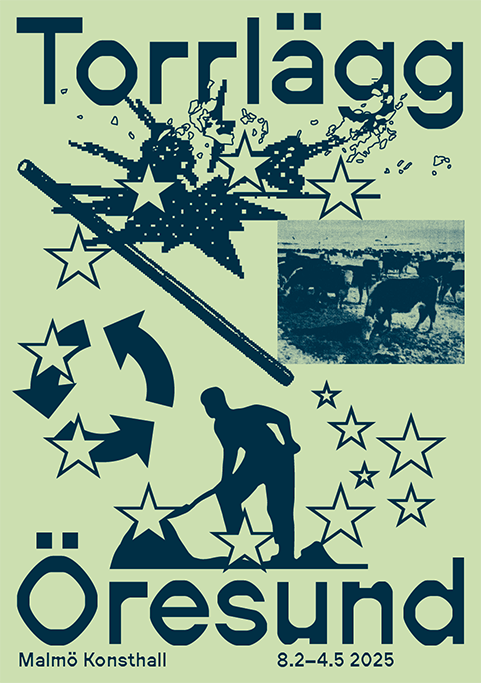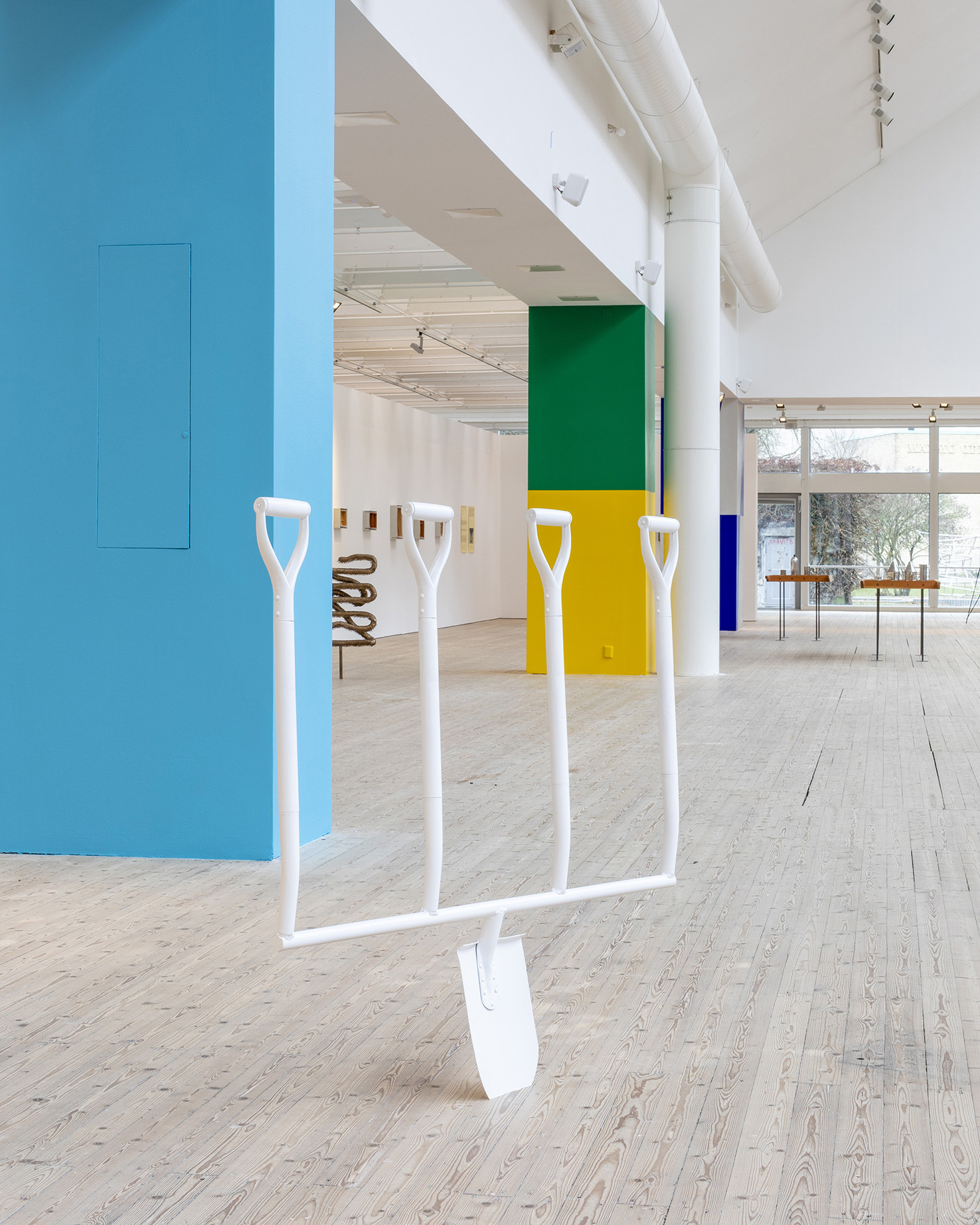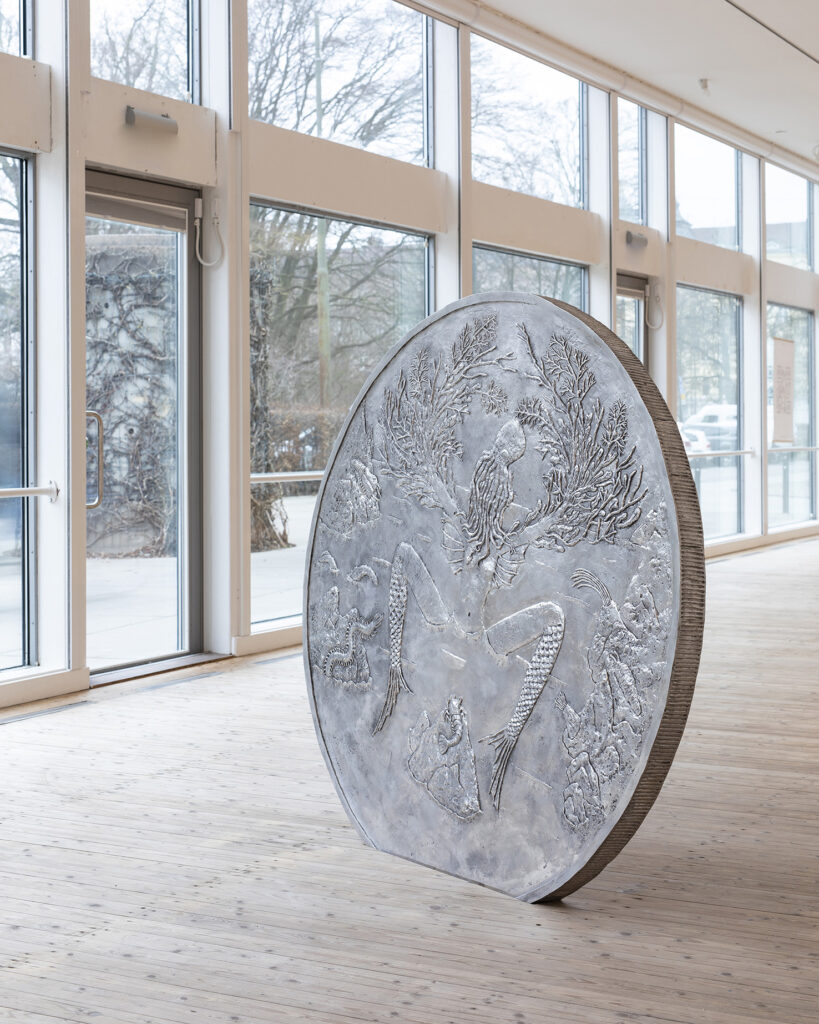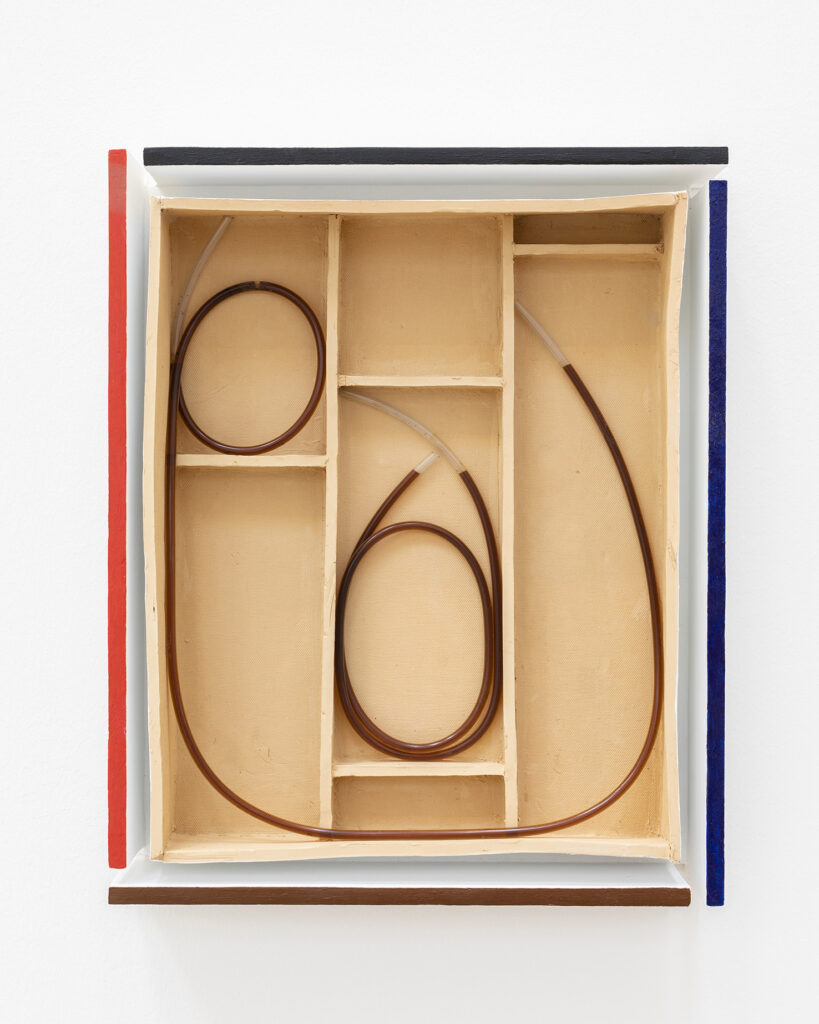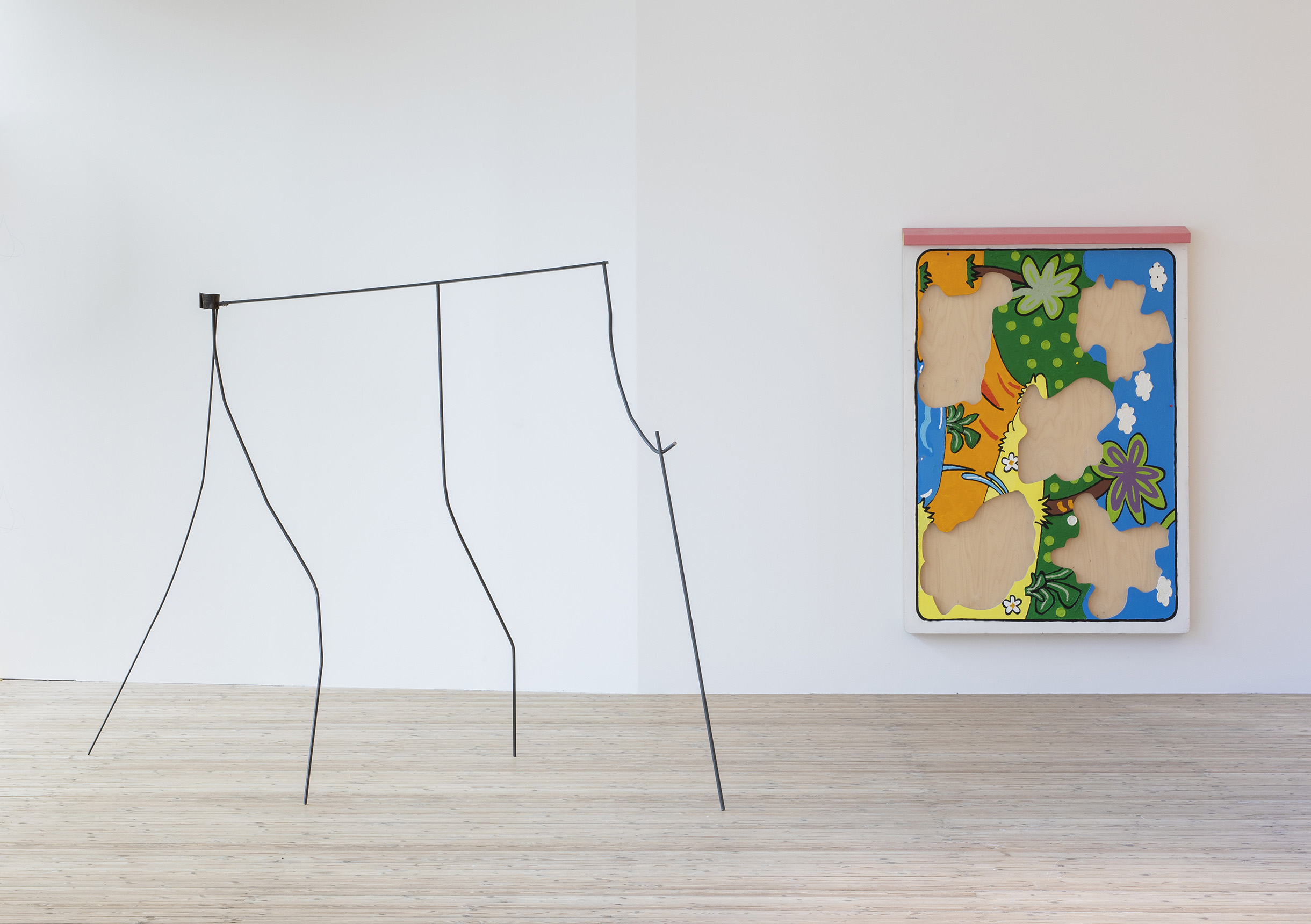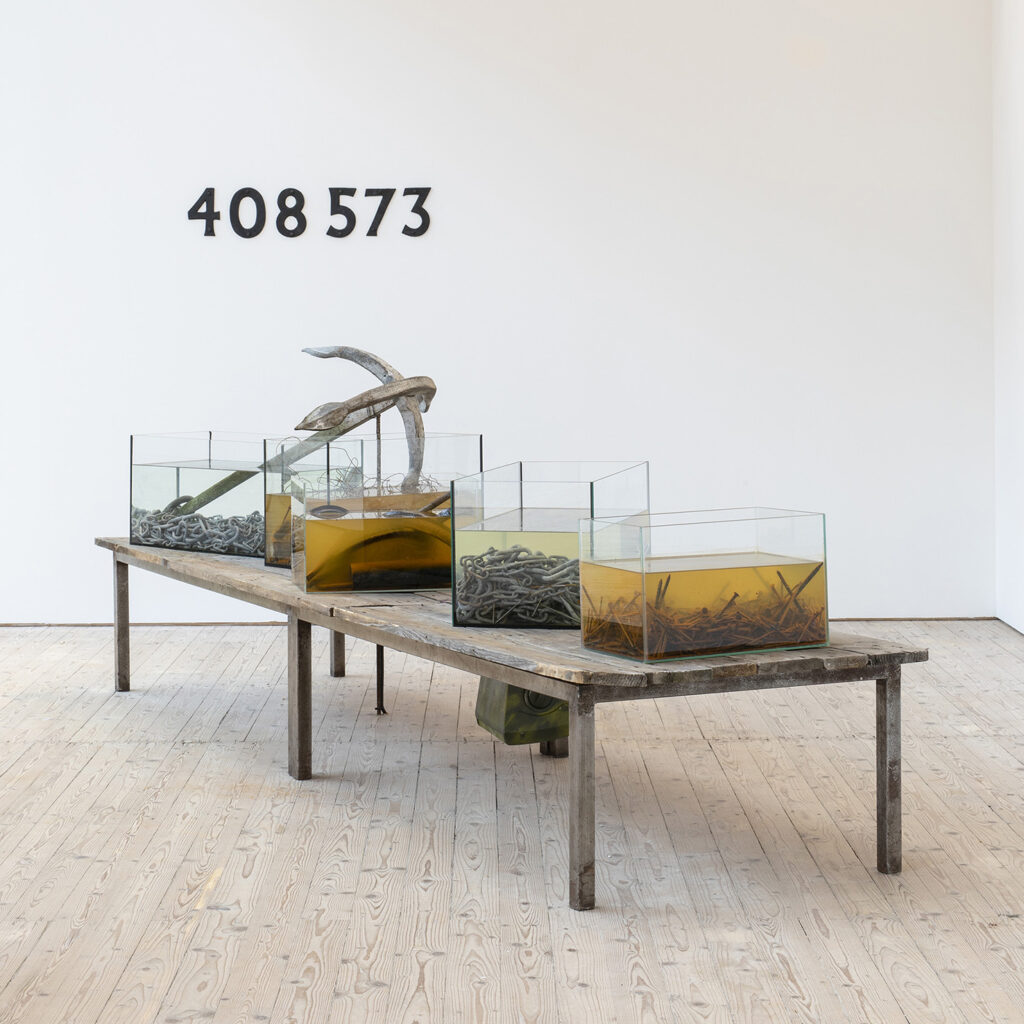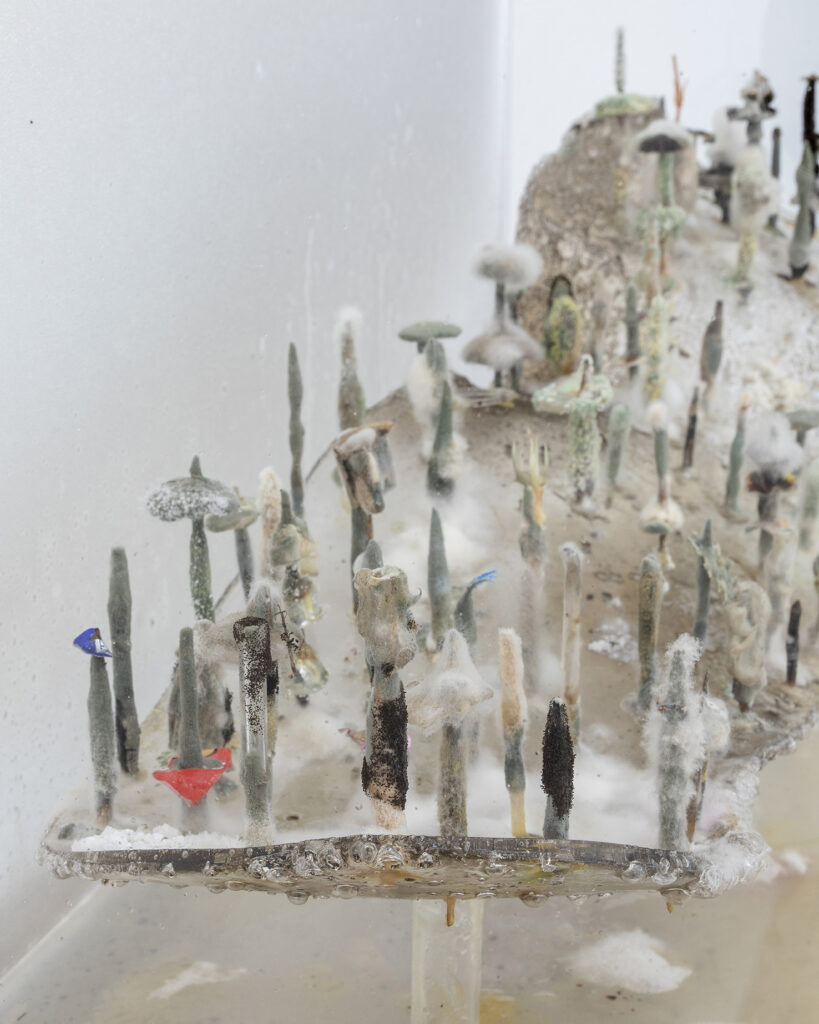
Drain the Öresund
8.2–4.5 2025
The exhibition “Drain the Öresund” brings together fourteen artists living on both sides of the Öresund to examine the region as a site of sociocultural, ecological, technological, economic, and political entanglements. Using local and regional narratives as a starting point, the exhibition explores broader global movements and processes – migration, climate change, economic development – to uncover the connections between fact and fiction, progress and decline, the self and the world.
Explores social transformations
The exhibition presents a critical perspective on the infrastructure of the welfare state, and the greenwashing employed by commercial actors to implement profit-driven projects. Many of the artworks highlight circuits of exchange and explore the hopes and failures of mass social transformation, digging into the increasingly muddy relationships between public and private, past and present, production and destruction.
Social historical perspective
What unites the artists is their exploration of how our societal structures impact human labour, human bodies, and our lived experiences. Several of the artists work from a social-historical perspective, investigating various movements and narratives in the region, often against the backdrop of climate change and privatisation. Many of the works are rooted in true stories about the region’s transformation and history – stories that the region has embraced, exploited, or rejected. Through artistic interpretation, these stories are opened up for new interpretations of labour, ecology, migration, and class.
Drain the Öresund!
In 1953, the Scanian industrialist Ruben Rausing made an ambitious proposal: drain the Öresund, thereby bringing Malmö and Copenhagen together and providing new space for development. Rather than viewing Rausing’s statement solely as an expression of capitalist logic driven by a desire for growth, the exhibition’s curator, Post Brothers, embraces the absurdity of the statement, treating it as an artistic provocation to reconsider ideas about national borders and development. For the exhibition, the curator was deeply inspired by Jesper Meijling’s 2000 text ‘All That Is Fluid Becomes Solid: Lecture on Landscape and Economy’, where the researcher and architect connects Rausing’s dream of redirecting the Öresund’s waters to the logistical thinking that characterizes his company, Tetra Pak, whose operations revolve around packaging liquid food products.
The possibilities of the borderland
Malmö has a strong and vibrant contemporary art scene. Drain the Öresund looks across the strait, exploring the region’s origins and direction, as well as the connection between Malmö and Copenhagen. What possibilities can be found in the in-between space of this borderland? And what materials, traumas and realities lie on the seabed? The exhibition adopts an absurd yet critically pessimistic approach to inspire new reflections, drawing on Rausing’s paradoxical idea as both an exaggeration of development rhetoric and a bold reimagining of the region. The thought of draining the Öresund is to drain it of its baggage and unearth its dark depths, uncovering what has been lost, and inspire new dreams for the region’s future.
The exhibition is made possible with support from the Polish Instituten and the Danish Arts Foundation
Participating artists:
Aleksandra Kucharska´s subdued drawings similarly examine the physical structures and atmospheres that order our lives, stimulating unresolved, almost dream-like narratives.
“I carry images within me; fragments from my childhood, everyday life, and dreams that constantly resurface, reminding me of something that was and something that is. In my dreams, I am transported to my former homes, former lands, former faces, former times.
The memories are like a sensation or a scent that slowly fades away. Sometimes, I manage to grasp a small detail of an object, a mood, or a place. The images blend with the present and transform into a new story. Sometimes I find solitary words in my sketchbooks that follow me, stubbornly insisting on being included. The words take shape in a building façade or spread out like a shadow in a drawing. Perhaps that’s why I return to the same sensations and fragments of memory—to embellish, alter, and relive, to shift and be shifted.”
Dag Kewenter is participating in the exhibition with the work “410757864530 DEAD LANDLORDS” (2021), which presents a morbid image of growth.
“The work departs from a critique of idealistic development. I was interested in the intersection between construction and destruction, progress and decay. By appropriating a ceremonial shovel—an object typically associated with the optimism of new beginnings in development—the sculpture subverts the traditional narrative of progress.
The choice to frame it within a context of funeral rites shifts the focus from celebration to mourning. This reversal taps into the idea of necropolitics, where the decisions surrounding life and death are influenced by power dynamics, often reflecting societal neglect or violence. Instead of digging the ground for new structures, this shovel could be seen as unearthing the remains of what has been lost. Rather than looking forward to the promises of development, the work urges viewers to confront the consequences of such endeavors. It calls attention to what lies beneath the surface: the buried pasts and the often overlooked human cost of progress.”
Hannibal Andersen’s ongoing project “The Abstract Expression of Privatization (Six Colour Marks)” explores colors as property and how companies claim exclusive rights to colors and color combinations, driven by fantasies of owning what belongs to no one and everyone.
“My contribution to Drain the Öresund is based on an ongoing investigation of colours as property. Today, companies can claim exclusive rights to the use of colours by registering them as trademarks, also known as “colour marks”, and thereby preventing others from using them.
This rendition of the work The Abstract Expression of Privatization consists of six colour marks that I have painted directly on the end wall and the freestanding columns in the Konsthall. The selected colours have been appropriated by companies that are leaders in areas such as “fast furniture,” forestry, global logistics, oil extraction, and energy for both machines and bodies.
Can you own a colour? What is next in line to be subjected to corporate private ownership? And what consequences will follow if we continue to ignore the plundering of the commons?”
“My sculptures have a starting point in theories about dehumanisation. But they are also dedications, monuments, for individuals featured in Herman Lundsborgs book Svenska folktyper published in 1919. These were migrants who had come to Sweden, and had been arrested and deported. Their mugshots were given to Lundborg, professor in the now-considered pseudo-science of racial hygiene, who used them as a warning against “racial mixture.”
Henriette Heise is participating with three works. Here, she shares the background of two of them: “Drawer” and “Tissue Technology”.
“The picture of this specific drawer is taken when I had my first institutional job as an associate professor at the Royal Academy in Copenhagen. On my first day at my new job, I sat there in my (first ever) office wondering what this new situation might bring to an artist who had been living the usual precarious freelance life since graduation. As a way of thinking about this new situation, I took a picture into the drawer of my desk. The interiority of this image is key to my work in general. I often think of the comment by the American artist Gregg Bordowitz that questioned not what constitutes politics in general, but rather what are the politics of the room you are in.”
“In films and on TV, there’s always a box of tissues in the therapist’s office—strategically placed between the therapist and the client, poised and ready. With its familiar silhouette, the tissue peeks out of the top of the box, proffered to wipe away tears and snot. The tissues solicit the feelings they would help ameliorate. And we know a breakthrough has occured when the client reaches for the box: One tissue pulls the next one up in an endless stream, each surfacing seamlessly from the depths of the box.Tissue Technology reveals the mechanism behind this circuit. Like TV, cinema and other screen based media, the box of tissues is a technology for manipulating sentiment, and simultaneously providing clean-up. A swirling machinery, hidden in plain sight on our screens, now exposed on a screen near you.”
Ina Nian´s installation “Black Noise #4” (2021–ongoing) draws attention to Sweden’s involvement in the transatlantic slave trade and colonialism.
“Historically, Skåne has been a foundation for Swedish Nazism, and it still has a strong foothold here. I was born and raised in Helsingborg, now living in Malmö, and my interest in history within my artistic practice has been shaped by this. I see history as a central part of how we understand ourselves – even our unheard, unseen history affects us.
The iron trade has made Sweden a wealthy country, but at a high cost for those at the bottom of the chain. When Sweden succeeded in the 17th century as a producer of the highly sought-after bar iron, we became a central figure in international iron trade, to the extent that historical documents refer to the “Swedish monopoly.” Much of the Swedish iron was bought by Great Britain, which used it for everything from everyday items to equipment for the navy that colonized West Africa. The sought-after status of Swedish iron meant that it, under the name ‘voyage iron,’ was shipped along the West African coast and then traded for enslaved people.
I want to portray the unspoken part of history, and our indifference towards it. Water becomes a way to illustrate the contradiction; beneath the smooth, glossy water surface, the iron remains, and the rust turns into blood.”
Jessica Olausson’s practice stages the confluence of seemingly disparate things, generating the cognition of complex narratives that are distributed across space and time. In “A Room Used to Gather” (2025), custom-built at the konsthall, the artist brings together a cabinet, flood defence barriers, an electronic votive candle stand, artificial ash, and a set of geographic coordinates.
”As a Swede living in Copenhagen, residing in the Öresund region means always existing in a state of in-betweenness—constantly between countries and coasts. It’s a place shaped by shifting boundaries, where the tension between human ambition and nature’s unruliness continues to unfold, maybe now more than ever. I find these complex dynamics endlessly fascinating, and it makes the region a very relevant context for me to work within.
I often think about thick air—when particles of dust turn so dense, they become visible. Air so heavy you could cut it with a knife. Or muddy water – at one moment completely transparent, in the next, utterly opaque. In my practice, I search for objects, phenomena, or events that embody this kind of blurriness. Things that exist in-between – both clear and cloudy, conspicuously absent yet densely present, or perhaps in suspension. Exploring these dualities is thrilling to me—seeing how they operate and circulate as functional things in the world.”
Kalle Brolin explores the history of Skåne with a focus on ecology, labor, and migration, and through the two industries that have primarily driven the region’s development and historically shaped it: coal mining and sugar beet cultivation.
“Ten years ago, I moved back to Skåne and since then have worked on a series of video works that connect two regional industries, the Skåne coal mines and the sugar mills. I use these as case studies to create visual art about everything that interests me – economic systems as a gnostic colossus, the recuperation of rebellious culture, the colonization of our love lives, the imprint of history in contested borderlands, and reading landscapes as if they were poetry.
The work I Am Come Again (2022–2024) is a dual-channel video installation where the two projections meet in the middle and overlap. In the overexposed central section, a door, an opening, emerges for those portrayed in the video. Groups of imprisoned or excluded people for whom seasonal work in the Skåne sugar beet fields becomes a temporary opportunity to cross borders: proletarian agricultural workers from Poland, patients from Sankt Lars, auxiliary workers, survivors from concentration camps, migrant workers during the pandemic. The video consists of a long series of visual footnotes to a story that begins with the parallel relocation of German war criminals and Holocaust survivors to the Skåne castles and manor houses where sugar beets were grown.”
“Landscapes of Doubt is a series that exists somewhere between traditional landscape painting, conceptual sculpture, and communication tools like bulletin boards or advertising stands. The works explore the multiple meanings of the word “landscape” – as a physical place, a mental and political terrain, and a metaphor for the future.
At the core of my practice is an investigation of change and the uncertainty it brings – both within ourselves, in nature, and across society. This sense of instability is reflected in the painted landscapes, whose imagery remains intentionally incomplete, with missing puzzle pieces that invite viewers to fill the gaps with their own imagination, making each encounter personal and ever-changing.
The works are part of an ongoing series that I began in 2018.”
Matilda Tjäder’s installation “Live and Breathe” is a site-specific sound work composed of recordings from the art hall’s ventilation system, transformers, and various electronic systems, captured during times when the building was closed to the public. The material has been analyzed, reworked, amplified, and composed into a dynamic six-channel sound piece. “Live and Breathe” is an amalgam of sound waves from the machines operating in the background of our modern buildings, and signals from complex protocols designed to go unnoticed. The work reconstructs these protocols by allowing their inherent frequencies and tones to emerge in a new form.
“Live and Breathe continues my exploration of the acoustic identity and character of spaces. In connection with my solo exhibition “spelling the wind without words” (Skånes konstförening, 2023), the local wind in Malmö became the protagonist, and the venue’s ventilation system its medium.
I grew up two kilometers from the bridgehead in Malmö and watched the Øresund Bridge being built as a child (I even sang at its inauguration with my school class). Back then, the bridge symbolized a new horizon, but over time I’ve come to question the narratives and marketing strategies that shaped the identity around the Øresund Bridge. This is something the Danish artist Asta Lynge and I have actively explored in The Strait Trilogy – our artistic take on the Nordic Noir genre.”
Sebastian Hedevang & Andreas Rønholt Schmidt explore the grittier aspects of the Øresund region’s history. Before modern sewage systems were introduced in the 1890s, human waste was collected and shaped into so-called “sludge cakes,” which were sold as fertilizer. This human waste was gathered by “kjeltringer”, or nightmen, a subjugated caste of workers considered outlaws, untouchables, and social outcasts. In the exhibition, they have arranged modernist-style kitchen utensils, pastries, and coffee on sludge cake molds, reconstructed from an archival photograph.
“Our collaboration resulted in an interest in the latrine history and infrastructure. The work takes shape from a shared pool of knowledge about popular spirituality and the hubristic solutions of technology. It is akin to the bleaching men and Rigshospitalet in von Trier’s The Kingdom—the spirituality of the folk figure intersecting with science’s piping and processing of matter. With that perspective in mind, we shape our work using art historical examples that parallel our theme: the latrine.”
Silas Inoue explores in his artistic practice climate, ecosystems, ecology, and economy, the capitalist instrumentalization of nature, as well as how human social structures interact with and reflect biological systems.
“I began collaborating with mold organisms after my former basement studio was flooded due to a heavy rainfall, that left Copenhagen out of order, and caused mold to grow on some of my stored works. Now, I find it funny to invite mold organisms into cultural institutions and collectors homes like a celebrated guest instead of an unwelcome intruder, like in the work ”Infrastructure”. On the front of another work, “Bond”, a sea goddess is depicted, surrendering to the desires of various creatures. I am interested in themes of attraction that also delves into dynamics of economic dependency and how the choices we invest in ultimately shape the world we create.”
Vibe Overgaard explores in her artistic practice how our bodies, perceptions of space, connections, and the environment are engaged in constant and close relationships with infrastructure: those systems, at micro and macro scales, through which energy, goods, ideas, waste, power, people, and finance are trafficked.
“The work Industrial Drifter is a sculptural hybrid between a ship and an industrial machine. The form is based on my interest in production, infrastructure, and economic cycles, which invites us to understand Scandinavian prosperity in a global context. The growth economy, in a Danish-Swedish welfare context, can seem generative, but it is inextricably linked to the climate crisis and social inequality, both locally and especially globally. What does it mean for Scandinavian self-understanding that prosperity is often regarded as a local/national achievement, when it is built on global exploitation? In the context of the exhibition’s theme, I chose the ship as a symbol of global infrastructure. The Øresund is, both from a historical and contemporary perspective, defined by maritime traffic and trade routes: a kind of economic corridor in and out of Scandinavia, which has been a major route in the hierarchical division of the planet’s resources.”
Curator: Post Brothers
As part of the exhibition program, Asta Lynge’s and Matilda Tjäder’s film “The Strait Trilogy” (2020–23) will be screened at the Panora cinema on March 4th at 18:00.

